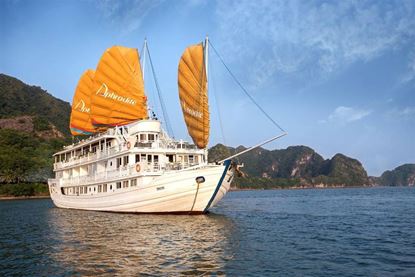Halong bay - The natural world heritage of Vietnam
With almost 2,000 limestone islets of all sizes and shapes dotted an area of over 1,500 km2 (larger than Hong Kong) Halong Bay is the only one of its kind.

Halong Bay - Viet Nam
The significant natural value of Halong Bay has been well documented a long time ago.
In 1994, UNESCO inscribed the bay as a World Heritage Site. It is one of the earliest listed sites in Southeast Asia.
6 years later, Halong Bay is recognized by UNESCO for the second time.
So what makes Halong Bay a two time recognized by UNESCO as World Heritage Site?
Amazing in Halong's cave
UNESCO has a total of 10 criteria for selecting a World Heritage Site.
Six of them are for cultural site and the other four are for natural site.
To be inscribed, a site must be of “outstanding universal value” of at least one criterion.
20 years ago, Halong Bay meets criterion VI: “contains superlative natural phenomena or areas of exceptional natural beauty and aesthetic importance”.
As mentioned before, with a multitude of untouched limestone islands rising from the sea, Halong Bay presents a spectacular seascape sculpted by the hands of Mother Nature.
Despite the fact that people have inhabited in the area for centuries, the serene natural beauty of the bay remains intact.
In this stunning maze of karst formations, nothing stays the same.
You will be amazed by not only the towering limestone pillars, but also the magnificent caves in Halong Bay.
Travelers would love to see Halong Bay on their postcard of Vietnam.
According to local legend ever since the first settlement of the country, Vietnam has been attacked from the sea.
Knowing this, the Jade Emperor sent Mother Dragon and her child down to help the Vietnamese against the invaders.
When enemy ships were approaching, the dragons flew down from the sky and spat countless pearls into the sea.
These turned into a myriad of jade islands. They linked together to create a solid wall that blocked the approaching enemy ships which crashed into the rocks and were torn to pieces.
After driving away the invaders, the Mother Dragon and her child were so charmed by the beauty of the bay that they decided to stay rather than returning to heaven.
Where the Mother Dragon landed was called Halong, her child settled in Bai Tu Long Bay, and where their tails entwined is Bach Long Vi Island.
Halong Bay was formed by millions of years of geological changes, which created thousands of islands.
Hidden inside these are beautiful caverns such as Sung Sot, Thien Cung, Trinh Nu and Thien Canh Son Caves, and Thien Cung Grotto.
Recognized by UNESCO as a World Natural Heritage site for its biodiversity, geology and nature, Halong Bay’s beauty and charm make it an outstanding tourism destination.
The landscape of Halong is attractive in each season.

